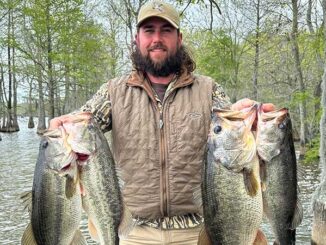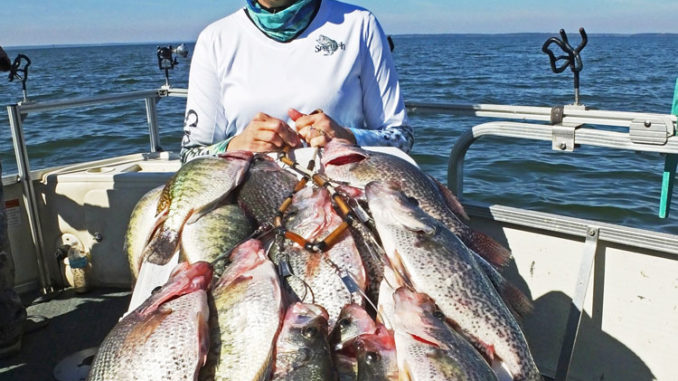
Lake Marion slabs can fill a cooler as easily in December as in the fall, if you can follow the movement of big schools into deeper water.
Cool weather and dropping water temperatures are a very good combination for December crappie on South Carolina’s Lake Marion. Anglers with a good game plan find that crappies begin to congregate into tighter areas around deep-water cover and score outstanding catches.
Guide Dave Hilton said anglers can make a few refinements from the excellent fall fishing and transition into outstanding cold-weather, crappie-catching action.
“Catching crappie from late November through December is not complicated, but it often requires me to be more mobile than at other times of the year looking for fish,” he said. “They’ll get into tight clusters in specific areas, but when we find them they’re usually stacked in like cordwood.”
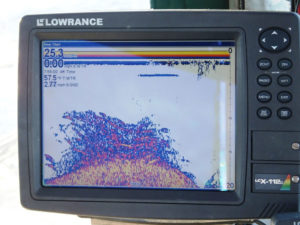
Hilton, who is from nearby Ridgeville, S.C., has guided clients to great crappie fishing for 28 years. He said the onset of colder water heats up the crappie action, and that patience is a key when searching for that hotspot.
“Using electronics, I work different areas until I can find fish, and it’s common to locate crappie in small and very specific depth and cover situations,” Hilton said. “The primary target for late-season crappies is brush and any other woody cover, whether natural or man-made. I keep brush piles along the base and top of drops and around humps and channels. At this time of year, I’ll begin working brush in water depths where I’ve recently caught fish, but if the action is slow, I’ll quickly start searching and usually will move deeper to find fish.”
Hilton said earlier in the fall, crappie action is often good in the 14- to 18-foot depths, but as the water cools, the fish move progressively deeper in Lake Marion. It’s common for crappies to be in the 18- to 30-foot depth range by December, but it varies year to year based on prevailing weather and water conditions.
“It’s crucial to understand although the trend is (that) crappies will migrate to deeper water if the water temperature drops, not every move is deeper at this time of year,” Hilton said.”Crappies will react to short-term weather changes and on cloudy and rainy days, especially. Immediately before a frontal passage, the low light and barometric conditions may have fish move slightly higher in the water column for short periods.”
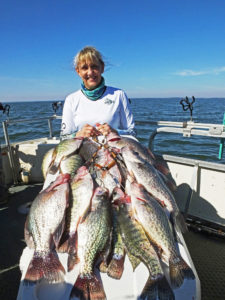
Hilton typically prefers live minnows fished vertically over the brush because minnows are a natural food source and are his go-to bait year-round. On the occasions he does use a jig, he will tip it with a live minnow.
“The addition of a minnow on a jig can produce excellent bites in the cooler water,” he said.
Kevin Davis, guide and owner of Blacks Camp on the Diversion Canal, said Lake Marion has a great population of crappie, and typically, the fish are on a strong bite in December.
“They’ll hit a variety of baits and lures, and often, I’ll experiment a bit to find the best bait or lure,” he said. “In addition to live minnows, I use two different lures for crappie in late-season.”
The first is a Ron’s Zip jig, a jighead with a tinsel trailer. He tips the jig with a minnow, he said, for “added enticement.
“On Lake Marion, I’ll often use a large minnow because many of the fish are white crappie, and they’ll bite a big minnow,” he said. “On Lake Moultrie, where I find more black crappie, I’ll use the smallest minnow I can find. That’s just another trade secret on how different the two lakes can be.”
The second is a Rockport Rattler, a jig with a rattling head loaded with a 11/2-inch squid-tail plastic trailer; he fishes it without a minnow. He holds the rig in his hands for better feel and lowers it to the right depth, giving it a light twitch every few seconds.
“The lure doesn’t need much action, and the rattler in the head does seem to draw the crappie close to check it out — and then they’ll bite,” Davis said. “Between the two types of rigs, we load up on some of the biggest crappie of the year during late November and December.
The deep-water brush pile pattern is strong throughout Lake Marion, but in the upper end of the lake, the abundance of natural, woody cover in an overall shallower environment enables anglers to utilize other techniques.
Davis said upper Lake Marion is a perfect example of a great opportunity to work natural cover for cold-weather crappie.
“The abundance of woody cover and the myriad of drops, ledges and deep holes provide the diversity needed to find crappie during cold weather,” he said. “I’ll use the graph to find submerged stump rows or get into standing trees and mark fish. Then I’ll spider-rig six to eight rods and use my electric motor or wind drift to work the stumps and trees where crappies are marked. It’s highly effective.”
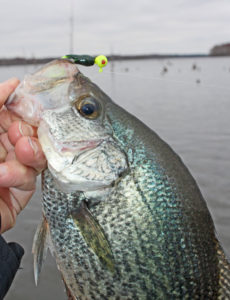
He said one final technique in the uppermost end of the lake can be excellent during the late-season.
“Working clumps of matted grass mats in the swamp after an extended warm-weather period can produce a bumper catch of crappies,” Davis said. “Use a long pole and a small jig and drop the lure in the small holes and openings in the matted grass. I simply slip the boat into the grass and start fishing all around the boat. I’ll move every few minutes until I start catching crappie. This can produce limits of quality fish in a hurry.”
DESTINATION INFORMATION
HOW TO GET THERE — Access Lake Marion either just north of I-26 between Charleston and Columbia, or via I-95 that crosses directly over Lake Marion near Santee providing access to fishing camps on both sides of the lake. The Diversion Canal connects the two lakes and is a prime area for fishing either lake, with fishing camps available for lodging, boat access and tackle supplies. For complete details visit www.santeecoopercountry.org.
WHEN TO GO — Late season, November and December, is prime time for slab crappie, and limits of big fish is a distinct possibility.
BEST TECHNIQUES — Crappie will orient to woody cover in Lake Marion, both natural cover and man-made brush piles. Use graphs to find underwater targets and to ensure forage and larger fish are in the area. Use live minnows and vertical fish over and around brush or tight-line multiple rods out of rod holders and work over natural cover such as stumps, logs and fallen trees. Precise depth and boat control is crucial to success.
FISHING INFO/GUIDES — Kevin Davis (843-312-3080), Dave Hilton (843-870-4734), Santee Cooper Country, 800-227-8510, www.santeecoopercountry.org. See also Guides & Charters in Classifieds.
ACCOMMODATIONS — Blacks Camp, 843-753-2231, Canal Lakes Fish Camp, 843-753-2271; Santee Cooper Country, 803-854-2131, 800-227-8510; www.santeecoopercountry.org.
MAPS — Fishing Hotspots, 800-338-5957; Kingfisher Maps, 800-326-0257, www.kfmaps.com; DeLorme’s South Carolina Atlas and Gazetteer, 207-846-7000, www.delorme.com.

